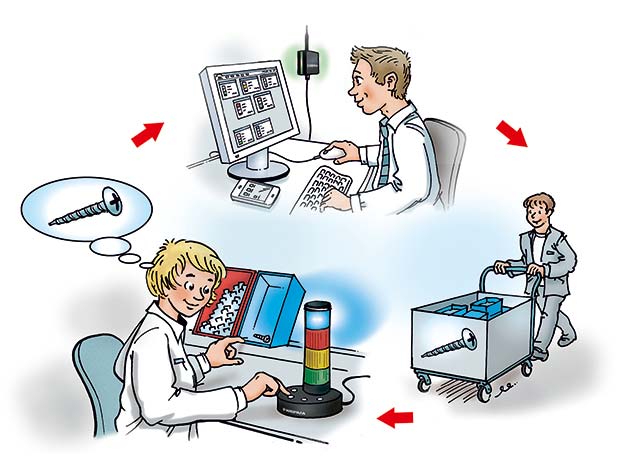Simple signals can be used to count parts, schedule production runs and maintenance, provide historical data and apply logic to existing machine statuses – and much more.
 A machine feature as simple as an andon light indicates the status of the machine – in operation, idle, or “down” Now, if the andon light activity can be more broadly communicated and the associated data collected and reported, the relevance and worth of the andon light increases dramatically.
A machine feature as simple as an andon light indicates the status of the machine – in operation, idle, or “down” Now, if the andon light activity can be more broadly communicated and the associated data collected and reported, the relevance and worth of the andon light increases dramatically.
Simple events (signals going ON or OFF) can now be leveraged to be so much more valuable. Design engineers and clever software writers have found ways to use these signals to create machine history, schedule preventive maintenance, display realtime machine status transparently, provide multiple machine statuses in one place, count parts, schedule production runs, provide summary reports, apply logic to existing machine statuses in combinations, and provide output signals as a headof- line function, etc. All of these advancements come from something that otherwise is often thought of as a minor option on an expensive piece of manufacturing equipment: an andon light.
For example, one of the enhancements that has become very popular is managing production runs and counting the output (e.g. parts) as they are being made. The most common andon light configuration is red-amber-green. If another colour, blue for example, is added a pulse can be sent to it indicating a part has just been made. This simple approach quickly becomes complex as operations staff want to do more with the data in attempts to control their processes. Just counting parts is not enough. Functionality features that production staff often want include:
• Scheduling production runs
• Queuing different production runs
• Customising equipment names and alarm / input names
• Setting alarm notifications at predetermined set-points of completion percentage (used to signify an upcoming production change-over)
• Providing an overall view of realtime machine status for the entire shop
• Creating individual machine histories
All of these benefits can be delivered through the data collection software of an otherwise simple andon light system such as SmartMONITOR developed and manufactured by WERMA.
Intelligent systems using andon lights – the smart alternative from WERMA
For the simpler cases that use andon lights, it is not enough to just collect the data (e.g. machine name, monitored parameter name, standard date and time). Something has to be done with it – the information needs to be shared with other staff. If done correctly it supports transparency within an operation. Smart phone technology opens up the communication of this information to more than a PC’s pop-up screen. Finding people remotely via e-mail and/or text is now the norm.
The sharing of performance data (both machinery and personnel) increases the transparency of a production process. For example, since the software has no licensing, anyone can see any other machine that has a transmitting stack light working in their network.
Andon lights have a key role in Industry 4.0 thinking
What does the future hold for this originally simple device flexing its muscles in a high-tech environment increasingly dominated by discussions about Industry 4.0 and the need to automate and digitalise information communication? The fact that wireless technology is here to stay predicts that there is much more creative advancement to come as what started out as simple warning lights are adapted to become smart and intelligent systems that simply work.
WERMA
Tel: 01536 486930




Comments are closed.